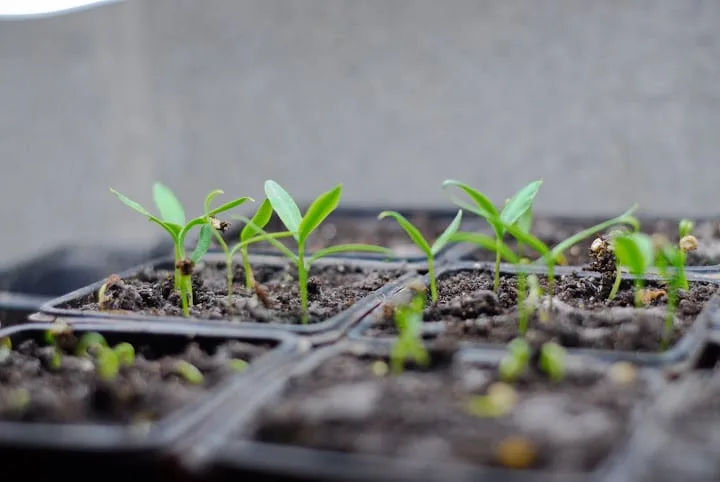How to Quickly Start Your Garden Seeds in a Germination Chamber

I’ve been farming for a very long time. And one of my favorite things to do is plant new seeds, especially with new varieties. It gives me a sense of excitement. My friend asked me why germinating seeds is so easy for me. Want to know my secret for getting my seeds to sprout more quickly? I use a germination chamber! Here’s how you can build your own.
Last week on Instagram I shared a photo of our new germination chamber loaded with trays of spinach, peppers, and tomatoes, there’s even a tray of ginger in there. I mentioned how impressed I was with how quickly the seeds were germinating and that so far I’m really happy with it this year. Most of the tomatoes were up in less than 48 hours and I had them out of the chamber and under the grow lights in 2 ½ days! Normally it’s at least 5 days.
Several folks spoke up wanting to know how we built it. (Questions, people, questions! I LOVE them! They help me to know what you want to know. I’m no mind reader, you know?)
What is a Germination Chamber Anyway?
Basically, a germination chamber is an insulated box that creates the ideal environment for quickly germinating your vegetable seeds for your vegetable garden. (Don’t forget these cold hardy veggies to start in the fall for your winter garden) In the bottom of the insulated box is a crockpot filled with water and plugged in on low. The warm water creates a warm, humid environment and seeds sprout in record time.
Though it seems like a big, and therefore expensive project, it was much cheaper than buying heat mats or building one of those tables with the heating coils in the sand. It was quick to build and took him only a few hours.

You can customize the height and width of your chamber to suit your needs. The depth needs to stay the same to accommodate the depth of a tray. Ours was built for no waste of materials using an 8′ long 2′ X 4′. The vertical framing pieces are 6 feet high, using the 2 feet cut-off as the depth. Two 4′ pieces were cut out of an 8-foot board for the width.
This is a guest-ish post of sorts. I’m only one lady and can’t do everything. Since I’ve got nothing to prove, I’m more than happy to delegate building projects to Bill. He’s better at it anyway and I’m better at baking cake so complement each other’s strengths and weaknesses.









I asked him to draw me up a list of materials and a rough outline of instructions so here you go! Here’s how he built our germination chamber:
How to Build a Germination Chamber
Materials
For a 6′ high, 2′ deep, wide chamber
3- Insulating Sheets- 4 ‘x 8’, 1-2 thick”
15- 2′ x 4′ x 8′
8- 10′, 3/4″ Conduit
1 tube- Construction Adhesive
2 sets- Hinges
Old crockpot
Humidistat
Directions
- Frame out with 2×4’s (including the doors) according to the desired size of your chamber.
- Cut the insulating panels to size and attach them to the frame with construction adhesive.
- To create the side rails for shelving, drill 1″ holes along the center. Begin 6″ in from one end and then 12″ spacing between the rest of the holes. (The last hole will be 6″ from the end.)
- Cut the board halfway between every 2nd & 3rd hole (so there are 2 holes per each 2′ section.
- Cut each 2′ board in half lengthwise so that the holes are now half-circles.
- Nail or screw to sides of the chamber, spacing them far enough apart to accommodate the height of a seed tray.
- Cut conduit to the width of the chamber and lay each piece in half circles.
- Attach the doors using the hinges.
Lighting is optional. (We have a fluorescent light and will probably switch over to string lights to provide a better light source all around the chamber.)
To use, fill the crockpot with water and set it on low. Set the humidistat in there so you can monitor the atmosphere.

More Germination Chamber Details
If we were building it again, I would have left enough room to accommodate a light on both sides. I would like to try string lights I think. See how the little seedlings are stretching? That way there is a bit less stress on the early risers reaching for the light while they’re waiting for the lazier seeds to pop up.
Technically, you shouldn’t need any lights at all just so long as you faithfully check on them and transfer them to the grow lights as soon as they’re up. The seedlings will just come up white or pale yellow. They’ll green right up once they come out. If you wait too long to transfer them to the light if they were started in the dark, the stems will get leggy. (Which is why you grow soil sprouts in the dark for the first few days. You’ll get more stems to eat.)
I’ve already learned that it’s much harder to keep the humidity up inside the chamber when there are only a few trays in it. When that’s the case I’m spraying the walls with water too which helps. I would definitely scale the height of your germination chamber to fit the highest quantity of seed trays you think you’ll have in there at any given time.
Do you use any techniques to give your seeds a jump start?







Can you go into more detail about how the crock pot works? Do you just run the cord out of the door and connect it to an extension cord? If that is the case, how do you secure the door closed? How do you manage/maintain the temperature inside, do you manually unplug and plug in when the temperature warrants a change? Thank you!
Kate
Have you done anything else to regulate the temperature or humidity? My configuration is very similar to yours; however, when it’s fully closed I reach above 90 degrees with nearly 95% humidity. Knowing that there are ideal germination conditions for every seed variety, I’ve been very hesitant to leave it maxed out. I have cracked the door which leaves it around 80 degrees and high 70s in humidity. I would like more control without having to hardwire other mechanisms into the setup.
I have a question, this is the second year we are using a germination chamber. We had great success last year but are trying some new seeds that require a longer germination time.
What do you do for seeds that require more time, is there a possibility they would rot?
So basically an incubator for seeds. I think this is an awesome idea. I have one of those husbands who I keep around for building things lol.
I have been setting the root end of head lettuce in a small amount of water, after I eat, or feed the rest to my chickens, and guess what, they have sproutted. Now I will need to put them in soil so that they can grow and make me some lettuce.
Ooh! I may have to build one of these! Thanks for sharing this
You’re welcome! 🙂